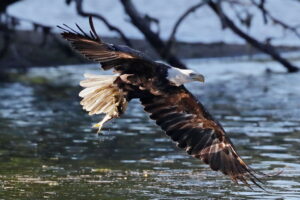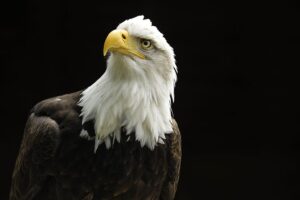The Bald Eagle: An Impressive Predator
The bald eagle can hunt from the sky, on land, or in the water.
By: Kelli Ballard | April 17, 2020 | 576 Words

(Photo by John Tlumacki/The Boston Globe via Getty Images)
The bald eagle is a majestic bird and a fierce predator. On June 20, 1782, it was chosen to be the emblem for the official seal of the United States.
The bird’s name is a bit deceptive since it has white feathers on its head and is not at all bald. The word “bald” is from an Old English word, “balde,” which means white, and its scientific name, Haliaeetus leucocephalus, translates as hali (sea), aetos (eagle), leukos (white), and cephalos (head): basically meaning a seabird with a white head.

(Photo by Bruce Bennett/Getty Images)
Habitat
The bald eagle has a life span of about 28 years in the wild. Its body is between 34 to 43 inches long with a wingspan of six to eight feet. It can weigh between six and 14 pounds.
Although these birds can be found in other regions across the United States, the majority of them live in Alaska (as well as Canada), usually by bodies of water where they can scavenge for carrion and use their strong, sharp talons to pluck fish from streams and lakes. They are known to travel great distances: California birds have been found in Alaska, and Florida eagles are sometimes seen as far as Michigan.
As with most birds, the bald eagle tends to prefer high ground for both its home and hunting. To get a “bird’s eye view,” they will usually settle on a high perch to search for prey, then swoop down to catch it with their talons. Sometimes they may wade into shallow water where a lot of fish are pooled together, such as during spawning season. If fish are scarce, the birds are known to go to ground as well, hunting on land. Although fish is the bald eagle’s preferred meal, it can and will eat other animals and crustaceans such as ducks, jackrabbits, muskrats, turtles, crabs, and shellfish. The eagle is also known as a scavenger that will steal prey from other birds – or even fishermen!
The Bald Eagle’s Life

(Photo by Jesse Wild/Digital Camera magazine via Getty Images)
It is believed that bald eagles mate for life and that both parents help in building their homes and raising their young. The male and female work together to build a huge nest, generally high in a tall tree. A large mound of sticks makes up the frame of the nest, and then finer materials line the inside for comfort, warmth, and protection.
The female usually lays two eggs per year, and both parents take turns watching over the eggs during incubation, which is about 35 days. After hatching, one parent will stay with the babies while the other will search for meals. The young are fed by the adult tearing the food into small pieces and feeding them directly. After three to six weeks, the babies will be able to peck at food dropped in the nest.
The young test their wings with their first flight at around ten to 12 weeks old.
Bald eagles were hunted to near extinction until a 1970s law made it illegal. The loss of their habitat as more humans encroached on the land added to their dwindling numbers, as did the pesticides that were used for crops. Thankfully, the laws protecting bald eagles as well as the discontinued use of certain chemicals have helped to increase their numbers and continue to do so.
















